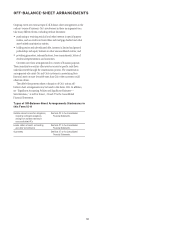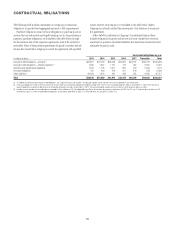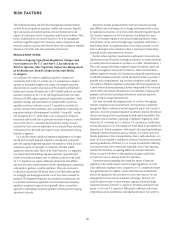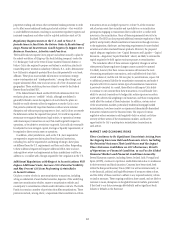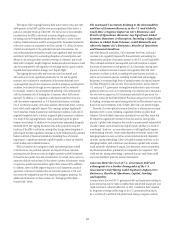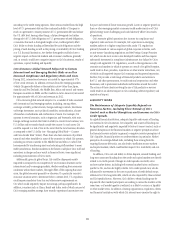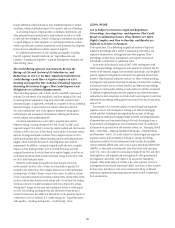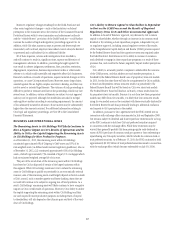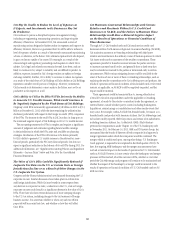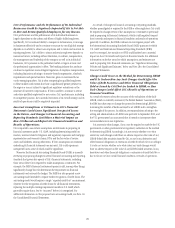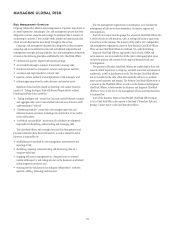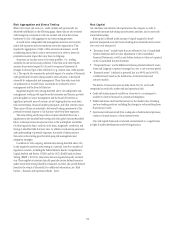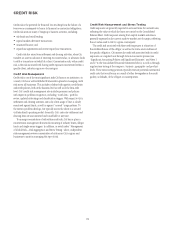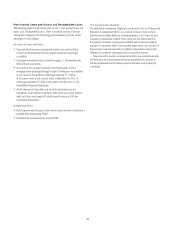Citibank 2012 Annual Report Download - page 90
Download and view the complete annual report
Please find page 90 of the 2012 Citibank annual report below. You can navigate through the pages in the report by either clicking on the pages listed below, or by using the keyword search tool below to find specific information within the annual report.68
Citi May Be Unable to Reduce Its Level of Expenses as
It Expects, and Investments in Its Businesses May Not
Be Productive.
Citi continues to pursue a disciplined expense-management strategy,
including re-engineering, restructuring operations and improving the
efficiency of functions. In December 2012, Citi announced a series of
repositioning actions designed to further reduce its expenses and improve its
efficiency. However, there is no guarantee that Citi will be able to reduce its
level of expenses, whether as a result of the recently-announced repositioning
actions or otherwise, in the future. Citi’s ultimate expense levels also depend,
in part, on factors outside of its control. For example, as a result of the
extensive legal and regulatory proceedings and inquiries to which Citi is
subject, Citi’s legal and related costs remain elevated, have been, and are
likely to continue to be, subject to volatility and are difficult to predict. In
addition, expenses incurred in Citi’s foreign entities are subject to foreign
exchange volatility. Further, Citi’s ability to continue to reduce its expenses
as a result of the wind-down of Citi Holdings will also decline as Citi Holdings
represents a smaller overall portion of Citigroup. Moreover, investments
Citi has made in its businesses, or may make in the future, may not be as
productive as Citi expects or at all.
Citi’s Ability to Utilize Its DTAs Will Be Driven by Its Ability
to Generate U.S. Taxable Income, Which Could Continue to
Be Negatively Impacted by the Wind-Down of Citi Holdings.
Citigroup’s total DTAs increased by approximately $3.8 billion in 2012 to $55.3
billion at December 31, 2012, while the time remaining for utilization has
shortened, particularly with respect to the foreign tax credit (FTC) component
of the DTAs. The increase in the total DTAs in 2012 was due, in large part, to
the continued negative impact of Citi Holdings on Citi’s U.S. taxable income.
The accounting treatment for DTAs is complex and requires a significant
amount of judgment and estimates regarding future taxable earnings
in the jurisdictions in which the DTAs arise and available tax planning
strategies. Realization of the DTAs will continue to be driven primarily
by Citi’s ability to generate U.S. taxable income in the relevant tax carry-
forward periods, particularly the FTC carry-forward periods. Citi does not
expect a significant reduction in the balance of its net DTAs during 2013. For
additional information, see “Significant Accounting Policies and Significant
Estimates—Income Taxes” below and Note 10 to the Consolidated
Financial Statements.
The Value of Citi’s DTAs Could Be Significantly Reduced If
Corporate Tax Rates in the U.S. or Certain State or Foreign
Jurisdictions Decline or as a Result of Other Changes in the
U.S. Corporate Tax System.
Congress and the Obama Administration have discussed decreasing the U.S.
corporate tax rate. Similar discussions have taken place in certain state
and foreign jurisdictions. While Citi may benefit in some respects from
any decrease in corporate tax rates, a reduction in the U.S., state or foreign
corporate tax rates could result in a significant decrease in the value of Citi’s
DTAs. There have also been recent discussions of more sweeping changes
to the U.S. tax system, including changes to the tax treatment of foreign
business income. It is uncertain whether or when any such tax reform
proposals will be enacted into law, and whether or how they will affect
Citi’s DTAs.
Citi Maintains Contractual Relationships with Various
Retailers and Merchants Within Its U.S. Credit Card
Businesses in NA RCB, and the Failure to Maintain Those
Relationships Could Have a Material Negative Impact
on the Results of Operations or Financial Condition of
Those Businesses.
Through its U.S. Citi-branded cards and Citi retail services credit card
businesses within North America Regional Consumer Banking (NA RCB),
Citi maintains numerous co-branding relationships with third-party
retailers and merchants in the ordinary course of business pursuant to which
Citi issues credit cards to customers of the retailers or merchants. These
agreements provide for shared economics between the parties and ways
to increase customer brand loyalty, and generally have a fixed term that
may be extended or renewed by the parties or terminated early in certain
circumstances. While various mitigating factors could be available in the
event of the loss of one or more of these co-branding relationships, such as
replacing the retailer or merchant or by Citi’s offering new card products, the
results of operations or financial condition of Citi-branded cards or Citi retail
services, as applicable, or NA RCB could be negatively impacted, and the
impact could be material.
These agreements could be terminated due to, among other factors,
a breach by Citi of its responsibilities under the applicable co-branding
agreement, a breach by the retailer or merchant under the agreement, or
external factors outside of either party’s control, including bankruptcies,
liquidations, restructurings or consolidations and other similar events that
may occur. For example, within NA RCB Citi-branded cards, Citi issues a co-
branded credit card product with American Airlines, the Citi-AAdvantage card.
As has been widely reported, AMR Corporation and certain of its subsidiaries,
including American Airlines, Inc. (collectively, AMR), filed voluntary
petitions for reorganization under Chapter 11 of the U.S. Bankruptcy code
in November 2011. On February 14, 2013, AMR and US Airways Group, Inc.
announced that the boards of directors of both companies had approved a
merger agreement under which the companies would be combined. The
merger, which is conditioned upon, among other things, U.S. Bankruptcy
Court approval, is expected to be completed in the third quarter of 2013. To
date, the ongoing AMR bankruptcy and the merger announcement have
not had a material impact on the results of operations for U.S. Citi-branded
cards or NA RCB. However, it is not certain when the bankruptcy and merger
processes will be resolved, what the outcome will be, whether or over what
period the Citi-AAdvantage card program will continue to be maintained and
whether the impact of the bankruptcy or merger could be material to the
results of operations or financial condition of U.S. Citi-branded cards or NA
RCB over time.


